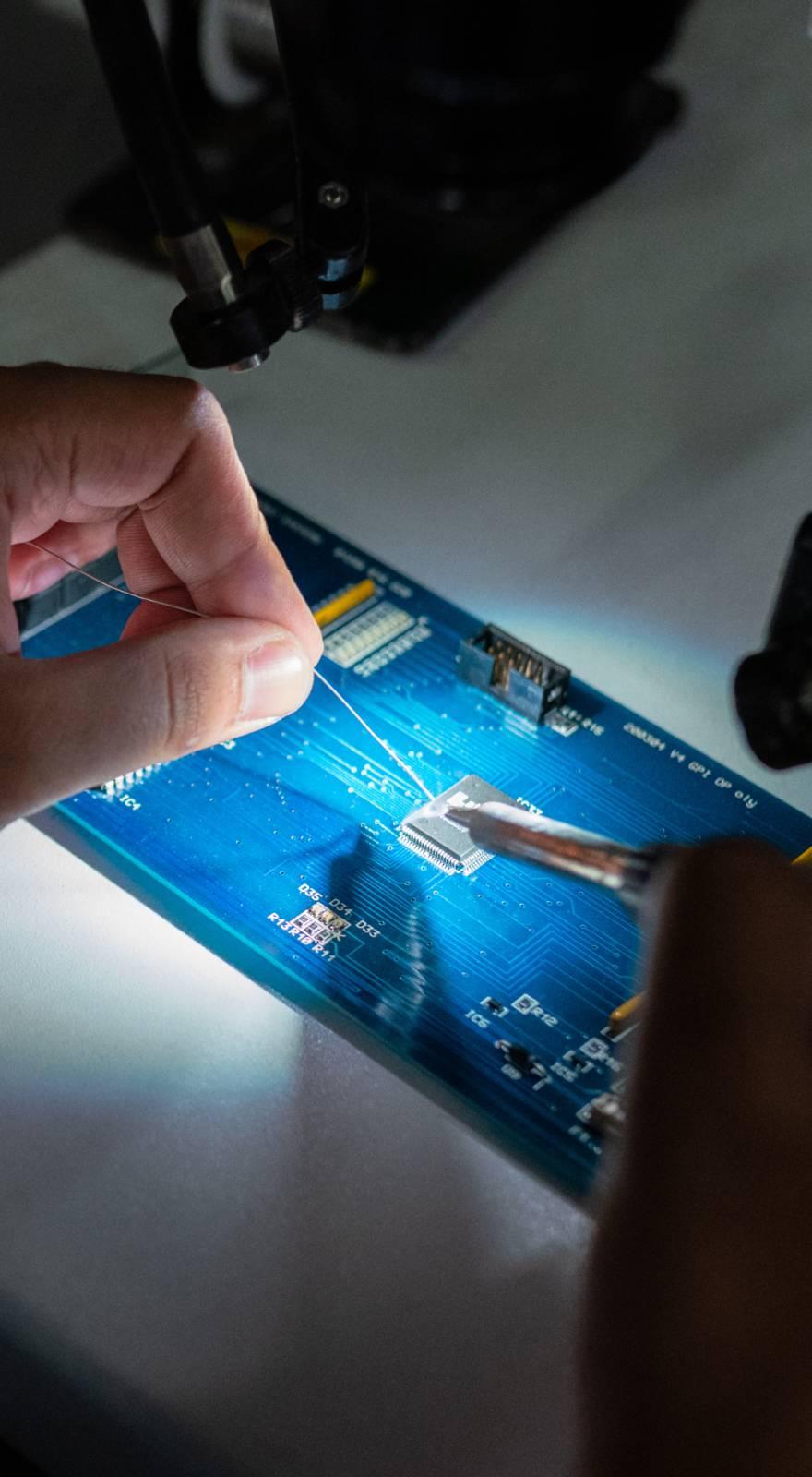Knowde Enhanced TDS
Identification & Functionality
- Chemical Family
- CASE Ingredients Functions
- Technologies
- Product Families
- Structure
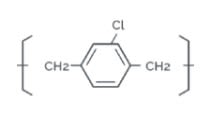
Features & Benefits
- Labeling Claims
Applications & Uses
- Applications
- Application Method
- Coating Type
- Uses
Parylene C is the best choice for:
- Implantable medical devices.
- Pinhole-free barrier layers to electronics or materials from harsh environments.
- Encapsulating electronics to provide dielectric protection.
Properties
- Flame Rating
- Mechanical Properties
- Typical Properties
- Thermal Properties
- Film Properties
- Electrical Properties
- Chemical Resistance
- Electrical Properties
- Parylene is a material with exceptional electrical insulation properties that can be applied in a conformal thin film.
- This combination allows parylene to be used as a precision dielectric layer in a variety of applications.
- Parylene’s breakdown voltage is determined by the coating thickness.
- When compared to epoxy, silicones, and urethane coatings, all parylene types have an extremely high dielectric strength.
- Parylene N is a unique dielectric material because of the extremely low dissipation factor which changes only slightly with frequency.
- The chlorine atom in parylene C increases the dielectric constant and dissipation factor when compared to parylene N.
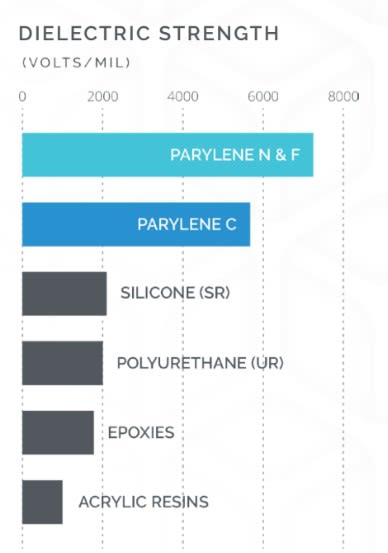
- Barrier Properties
- Parylene is an extremely effective moisture and chemical barrier layer that can be used to protect materials from an incompatible environment.
- Parylene is able to fully encapsulate medical devices, electronics and oxidative materials from harsh environments with a very thin and conformal parylene layer.
- Parylene is chemically resistant to almost every solvent, acid and alkaline chemistry commonly used.
- This allows parylene to be used in environments that simply are impossible for other conformal coatings.
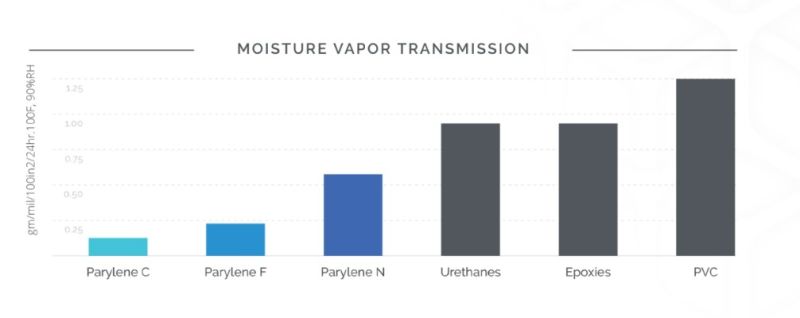
- Mechanical Properties
- Parylene is a crystalline polymer which results in generally high mechanical strength.
- Parylene has a relatively high tensile and yield strength compared to other polymer coatings.
- Parylene has a hardness higher than polyurethane and epoxy. However, it has the approximate hardness of human skin.
- Although parylene’s wear resistance is substantial, it isn’t recommended to be used in applications with repeated abrasion with harder materials.
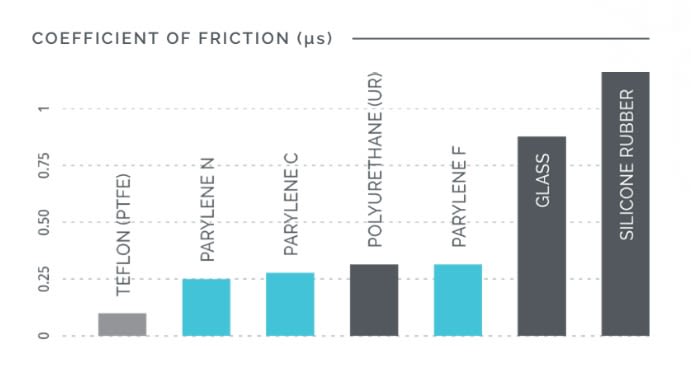
- Thermal Properties
- Parylene, like all polymers, has an ideal temperature operating range which is dependent on the application and environment.
- At temperatures outside the ideal temperature operating range, parylene will start to become translucent or yellow and will become brittle.
- The operating temperature range increases significantly if parylene can be used in the absence of air or in inert atmospheres. In an oxygen-free environment, oxidative degeneration does not take place.
- Degradation is due primarily to the thermal cleavage of carbon-carbon bonds.
- If high temperature is a concern, VSI recommends every application is looked at and tested individually.
- Each parylene type’s melting temperature defines an upper limit. The table to the right gives guidelines for 1,000 hour use and continuous use to demonstrate parylene melting points.
- On the other end of the temperature spectrum, parylene is outstanding in cryogenic applications. As an example, steel panels coated with parylene C that were chilled in liquid nitrogen to -160°C withstood impacts of more than 100 in/lb.
- Unsupported 2-mil films of parylene C were flexed 190 degrees six times at -165°C before failure occurred.
- At even lower temperatures, near absolute zero, tests show that parylene N provides the best electrical insulation of any known plastic.
- Neither electrical or physical properties are noticeably affected by cycling from -270°C to room temperature.
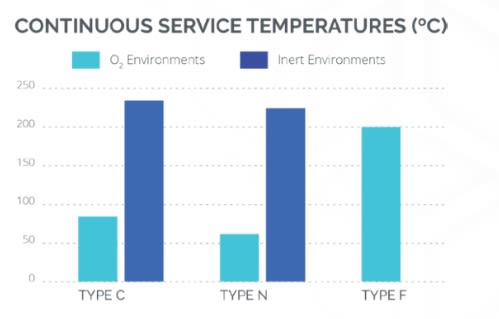
| Value | Units | Test Method / Conditions | |
| Coefficient of Friction (static and dynamic) | 0.29 | — | — |
| Hardness | R80 | — | Rockwell |
| % Elongation to Break | 20 - 200 | % | — |
| Young’s Modulus | 2.8 | GPa | — |
| Tensile Strength | 10000.0 | psi | — |
| Tensile Strength | 68.9 | MPa | — |
| Yield Strength | 8000.0 | psi | — |
| Yield Strength | 55.2 | MPa | — |
| Elongation to Break | 20 - 200 | % | — |
| Elongation at Yield | 2.9 | % | — |
| Density | 1.289 | g/cm³ | — |
| Hardness (Rockwell) | R80 | R | — |
| Coefficient of Friction (Static) | 0.29 | — | — |
| Coefficient of Friction (Dynamic) | 0.29 | — | — |
| Value | Units | Test Method / Conditions | |
| Gas Permeability (Oxygen at 25°C) | 2.8 | cc*mm/m²*day*atm | — |
| Penetration Power | 5X | — | — |
| USP Class VI Polymer | Yes | — | — |
| Gas Permeability (Nitrogen) | 0.4 | cc*mm/m²*day*atm | — |
| Gas Permeability (Carbon Dioxide) | 3 | cc*mm/m²*day*atm | — |
| Gas Permeability (Hydrogen) | 43.3 | cc*mm/m²*day*atm | — |
| Value | Units | Test Method / Conditions | |
| Short Term Service Temperature (in oxygen environments) | 115 | °C | — |
| Continuous Service Temperature (in oxygen environments) | 80 | °C | — |
| Short Term Service Temperature (in inert environments) | 350 | °C | — |
| Continuous Service Temperature (in inert environments) | 230 | °C | — |
| Thermal Conductivity (at 25° C) | 0.084 | W/m*K | — |
| Specific Heat | 0.17 | cal/g*°C | — |
| Melting Point | 290.0 | °C | — |
| Melting Point | 290 | °C | — |
| Short-term Service Temperature (Oxygen Environment) | 115.0 | °C | — |
| Short-term Service Temperature (Inert Environment) | 350.0 | °C | — |
| Continuous Service Temperature (Oxygen Environment) | 80.0 | °C | — |
| Continuous Service Temperature (Inert Environment) | 230.0 | °C | — |
| Linear Coefficient of Thermal Expansion (at 25° C) | 35.0 | ppm/°C | — |
| Linear Coefficient of Thermal Expansion (at 25° C) | 35 | ppm/°C | — |
| Thermal Conductivity (25°C) | 0.084 | W/mK | — |
| Specific Heat (20°C) | 17.0 | cal/g°C | — |
| Value | Units | Test Method / Conditions | |
| Nitrogen Gas Permeability (25°C) | 0.4 | (ccxmm)/(m²xdayxatm) | — |
| Oxygen Gas Permeability (25°C) | 2.8 | (ccxmm)/(m²xdayxatm) | — |
| Carbon Dioxide Gas Permeability (25°C) | 3.0 | (ccxmm)/(m²xdayxatm) | — |
| Hydrogen Gas Permeability (25°C) | 43.3 | (ccxmm)/(m²xdayxatm) | — |
| Value | Units | Test Method / Conditions | |
| Dielectric Strength (25.4microns) | 220.0 | V/micron | — |
| Dielectric Strength (0.001”) | 5600.0 | V/mil | — |
| Volume Resistivity (23°C, 50% RH) | 8.8x10¹⁶ | ohm-cm | — |
| Surface Resistivity (23°C, 50% Relative Humidity) | 1x10¹⁴ | ohms | — |
| Dielectric Constant (60Hz) | 3.15 | — | — |
| Dielectric Constant (1KHz) | 3.1 | — | — |
| Dielectric Constant (1MHz) | 2.95 | — | — |
| Dielectric Constant (6GHz) | 3.06 - 3.10 | — | — |
| Dielectric Strength (at 0.001”) | 5.6 | KV/mil | — |
| Dissipation Factor (60Hz) | 0.02 | — | — |
| Dissipation Factor (1KHz) | 0.019 | — | — |
| Volume Resistivity (at 23°C, 50% RH) | 8.8x10¹⁶ | ohm-cm | — |
| Dissipation Factor (1MHz) | 0.013 | — | — |
| Surface Resistivity (at 23°C, 50% Relative Humidity) | 1x10¹⁴ | ohms | — |
| Dissipation Factor (6GHz) | 0.0002 - 0.0010 | — | — |
| Dielectric Constant (at 1MHz) | 2.95 | — | — |
| Dissipation Factor (at 1MHz) | 0.013 | — | — |
| Value | Units | Test Method / Conditions | |
| Hydrochloric Resistance (10%, Non-Oxidizing Acid, 25°C) | 0.0 | % | — |
| Hydrochloric Resistance (10%, Non-Oxidizing Acid, 75°C) | 0.0 | % | — |
| Hydrochloric Resistance (37%, Non-Oxidizing Acid, 25°C) | 0.0 | % | — |
| Hydrochloric Resistance (37%, Non-Oxidizing Acid, 75°C) | 4.1 | % | — |
| Sulfuric Resistance (10%, Non-Oxidizing Acid, 25°C) | 0.3 | % | — |
| Sulfuric Resistance (10%, Non-Oxidizing Acid, 75°C) | 0.2 | % | — |
| Sulfuric Resistance (95 - 98%, Non-Oxidizing Acid, 25°C) | 0.4 | % | — |
| Sulfuric Resistance (95 - 98%, Non-Oxidizing Acid, 75°C) | 5.1 | % | — |
| Nitric Resistance (10%, Non-Oxidizing Acid, 25°C) | 0.1 | % | — |
| Nitric Resistance (10%, Non-Oxidizing Acid, 75°C) | 0.1 | % | — |
| Nitric Resistance (71%, Non-Oxidizing Acid, 25°C) | 0.2 | % | — |
| Nitric Resistance (71%, Non-Oxidizing Acid, 75°C) | 0.0 | % | — |
| Chromic Resistance (10%, Non-Oxidizing Acid, 25°C) | 0.1 | % | — |
| Chromic Resistance (10%, Non-Oxidizing Acid, 75°C) | 0.0 | % | — |
| Chromic Resistance (74%, Non-Oxidizing Acid, 25°C) | 0.0 | % | — |
| Chromic Resistance (74%, Non-Oxidizing Acid, 75°C) | 7.8 | % | — |
| Sodium Hydroxide Resistance (10%, Base, 25°C) | 0.0 | % | — |
| Sodium Hydroxide Resistance (10%, Base, 75°C) | 0.5 | % | — |
| Ammonium Hydroxide Resistance (10%, Base, 25°C) | 0.2 | % | — |
| Ammonium Hydroxide Resistance (10%, Base, 75°C) | 0.4 | % | — |
| De - Ionized Water Resistance (100%, Inert, 25°C) | 0.0 | % | — |
| De - Ionized Water Resistance (100%, Inert, 75°C) | 0.0 | % | — |
| Isopropyl Resistance (Alcohol, 25°C) | 0.1 | % | — |
| Isopropyl Resistance (Alcohol, 75°C) | 0.2 | % | — |
| Iso - Octane Resistance (Aliphatic Hydrocarbon, 25°C) | 0.4 | % | — |
| Iso - Octane Resistance (Aliphatic Hydrocarbon, 75°C) | 0.5 | % | — |
| Pyridine Resistance (Amine, 25°C) | 0.5 | % | — |
| Pyridine Resistance (Amine, 75°C) | 0.7 | % | — |
| Xylene Resistance (Mixed, 25°C) | 2.3 | % | — |
| Xylene Resistance (Mixed, 75°C) | 3.3 | % | — |
| Trichloroethylene Resistance (TCE, 25°C) | 0.8 | % | — |
| Trichloroethylene Resistance (TCE, 75°C) | 0.9 | % | — |
| Chlorobenzene Resistance (Chlorinated Aromatic, 25°C) | 1.5 | % | — |
| Chlorobenzene Resistance (Chlorinated Aromatic, 75°C) | 2.0 | % | — |
| O-Dichlorobenzene Resistance (Chlorinated Aromatic, 25°C) | 3.0 | % | — |
| O-Dichlorobenzene Resistance (Chlorinated Aromatic, 75°C) | 1.4 | % | — |
| Trichlorotrifluoroethane Resistance (Fluorocarbon, 25°C) | 0.2 | % | — |
| Trichlorotrifluoroethane Resistance (Fluorocarbon, 75°C) | 0.3 | % | — |
| Acetone Resistance (Ketone, 25°C) | 0.9 | % | — |
| Acetone Resistance (Ketone, 75°C) | 0.9 | % | — |
| 2,4-Pentanedione (Ketone, 25°C) | 1.2 | % | — |
| 2,4-Pentanedione (Ketone, 75°C) | 1.8 | % | — |
Regulatory & Compliance
- Certifications & Compliance
- Regulation
Parylene C meets IPC-CC-830 or MIL-I-46058C standards.
